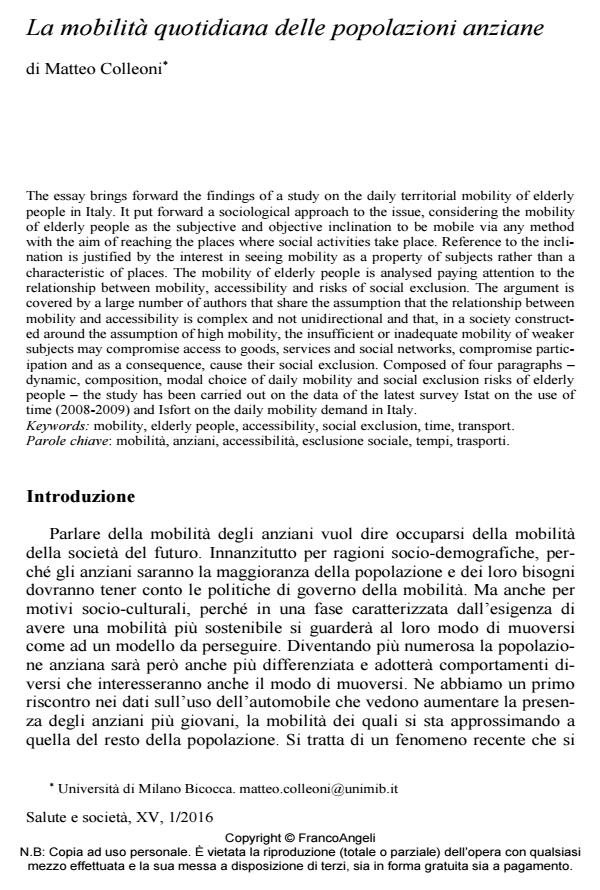La mobilità quotidiana delle popolazioni anziane
Titolo Rivista SALUTE E SOCIETÀ
Autori/Curatori Matteo Colleoni
Anno di pubblicazione 2015 Fascicolo 2016/1
Lingua Italiano Numero pagine 19 P. 116-134 Dimensione file 354 KB
DOI 10.3280/SES2016-001009
Il DOI è il codice a barre della proprietà intellettuale: per saperne di più
clicca qui
Qui sotto puoi vedere in anteprima la prima pagina di questo articolo.
Se questo articolo ti interessa, lo puoi acquistare (e scaricare in formato pdf) seguendo le facili indicazioni per acquistare il download credit. Acquista Download Credits per scaricare questo Articolo in formato PDF

FrancoAngeli è membro della Publishers International Linking Association, Inc (PILA)associazione indipendente e non profit per facilitare (attraverso i servizi tecnologici implementati da CrossRef.org) l’accesso degli studiosi ai contenuti digitali nelle pubblicazioni professionali e scientifiche
The essay brings forward the findings of a study on the daily territorial mobility of elderly people in Italy. It put forward a sociological approach to the issue, considering the mobility of elderly people as the subjective and objective inclination to be mobile via any method with the aim of reaching the places where social activities take place. Reference to the inclination is justified by the interest in seeing mobility as a property of subjects rather than a characteristic of places. The mobility of elderly people is analysed paying attention to the relationship between mobility, accessibility and risks of social exclusion. The argument is covered by a large number of authors that share the assumption that the relationship between mobility and accessibility is complex and not unidirectional and that, in a society constructed around the assumption of high mobility, the insufficient or inadequate mobility of weaker subjects may compromise access to goods, services and social networks, compromise participation and as a consequence, cause their social exclusion. Composed of four paragraphs - dynamic, composition, modal choice of daily mobility and social exclusion risks of elderly people - the study has been carried out on the data of the latest survey Istat on the use of time (2008-2009) and Isfort on the daily mobility demand in Italy.
Parole chiave:Mobilità, anziani, accessibilità, esclusione sociale, tempi, trasporti.
- Corpi che invecchiano in città che cambiano. Persone anziane e vita quotidiana in contesti urbani tra senso di appartenenza ed esclusione Magda Bolzoni, Valeria Cappellato, Eugenia Mercuri, in SOCIOLOGIA URBANA E RURALE 137/2025 pp.7
DOI: 10.3280/SUR2025-137001 - Questioning Proximity - Opportunities and Challenges for Urban Planning and Mobility Policies Matteo Colleoni, Luca Daconto, Simone Caiello, pp.31 (ISBN:978-3-031-66070-2)
- Social Exclusion in Later Life Florent Cholat, Luca Daconto, pp.141 (ISBN:978-3-030-51405-1)
Matteo Colleoni, La mobilità quotidiana delle popolazioni anziane in "SALUTE E SOCIETÀ" 1/2016, pp 116-134, DOI: 10.3280/SES2016-001009